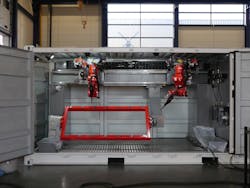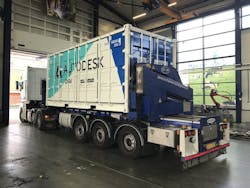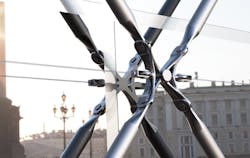Additive manufacturing heads to the jobsite
In September 2017, a partnership that included Autodesk and the Rotterdam Additive Manufacturing LAB in the Port of Rotterdam unveiled the first ship propeller to be made using 3D printing techniques.
The triple-blade, 1.35-meter diameter, 400-kilogram (881 lb) WAAMpeller was designed by Netherlands-based Promarin. It was fabricated from a nickel-aluminum-bronze alloy and produced with the Wire Arc Additive Manufacturing method using a welding system from Valk Welding and Autodesk’s Powermill software, which worked out the computer-aided manufacturing (CAM) strategy for the propeller’s curved geometry.
Autodesk’s additive manufacturing facility in Birmingham, England, CNC-milled the propeller, which was installed onto a tugboat. The project took seven months from design to installation to testing—but only a few full days of actual 3D printing.
Autodesk sees a future where manufacturing and construction converge. “Architects and builders are looking to manufacturing to make the construction process more efficient and repeatable—more connected,” says Nicolas Mangon, Autodesk’s Vice President of AEC Strategy and Marketing.
His company’s curiosity was peaking at a time when demand for additive manufacturing (AM) was taking flight. Heavy hitters such as General Electric, Boeing, BASF Venture Capital, and Airbus are committed to this process, either as investors or producers.
Wohlers’ 2018 Report on the Global 3D printing sector estimates that the AM industry grew by 21% to $7.3 billion in 2017, and could hit $21 billion by 2020. Wohlers also reported that 135 companies were producing and selling industrial AM systems in 2017, up from 97 the previous year.
ADDITIVE MANUFACTURING GOES MOBILE
Autodesk has jumped into the fray by creating a large-scale AM “toolbox” contained within a tricked-out 21-foot-long shipping container weighing 17,636 lb. The toolbox is equipped with two Panasonic TS-950 robotic arms, supplied by Valk Welding, that can weld, 3D print, cut, and polish objects. The robots have a total of 21 axis points and slide horizontally along a rail attached to the container’s back wall.
This mobile printing and repair shop cost about $483,110 to assemble, according to Elbert Vonk, Sales Engineer with Valk Welding, who was manning the booth displaying a working prototype at the recent Autodesk University in Las Vegas. Vonk said the robots are fed by a super-active wire process that allows welding without splatter, “which is very important for 3D printing.”
“What the team is doing is testing the robots, demonstrating the toolbox’s mobility, and gauging the strength of the materials produced,” said Johnny van der Zwaag, Project Manager Research and Innovation Projects with Autodesk’s Digital Manufacturing Group in Hoofddorp, The Netherlands, who was also at the Vegas conference.
Autodesk reached out to its customers for ideas about how this apparatus might be useful in the field. One of those customers—Dura Vermeer, a Netherlands-based construction engineering company that’s a frontrunner in digital construction—responded with three suggestions from its own experiences:
• Making tailored components for tolerance-sensitive connections. One of Dura Vermeer’s headaches is trying to jury-rig off-the-shelf components for connecting glass curtain wall to steel structures. The company believes that a combination of AM technology and generative design can produce customized “steel spider” connectors that would result in perfectly-fitted, easier-to-install components with optimized weight.
• Integrated structural components. Dura Vermeer’s second idea calls for using generative design to consolidate 10 different components into a single specialized element in order to simplify its supply chain, cut down on labor for installation, and generate components of higher architectural quality.
• Redesign complex structural connections into holistic nodes. Structures that architects and engineers present often need to be cut into pieces to be produced, and then reassembled at jobsites. With mobile AM, more components could be produced onsite, thereby reducing redundant work, and printing parts that are both functional and more closely aligned to the building’s design intent.
In a written response to questions from BD+C, Dura Vermeer stated that it is currently investigating with its equipment department which components it might produce this way. “We want to wait for the results of this pilot first, so we do not yet have a next stage in mind. But we have high expectations, so if things work out the way we hope, there certainly will be a follow-up.”
Several times during its conference, Autodesk executives pointed out that 70% of all spare parts produced never get used. Van der Zwaag hinted that printing bespoke metal spare parts could turn out to be one of the toolbox’s most sought-after utilities.
Imagine a factory in a remote location. One of its machine’s parts malfunctions, and the facility doesn’t have a spare. Under normal circumstances, that factory might need to wait a day—and maybe longer—for a replacement part to arrive, sidelining the machine in the meantime. But a mobile shop could be trucked to the site and 3D print a new part within hours, minimizing the plant’s downtime.
Mangon says that Autodesk intends to take its mobile toolbox on the road throughout Europe in 2019 “to see how other companies might use this technology.”


